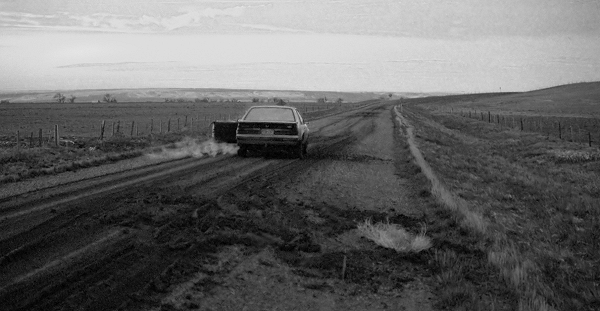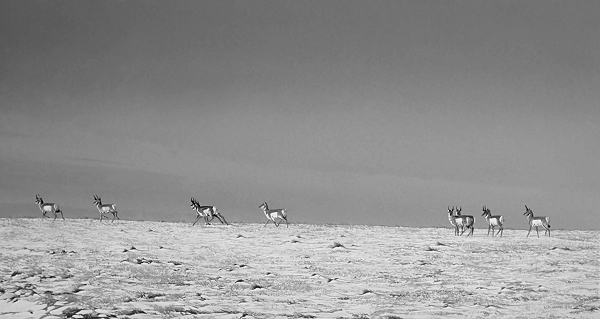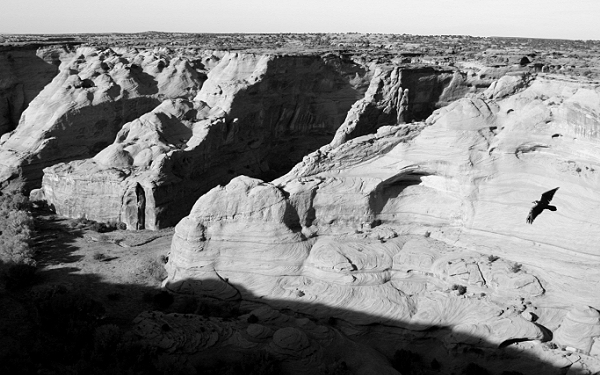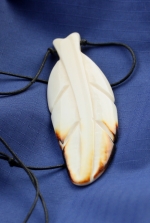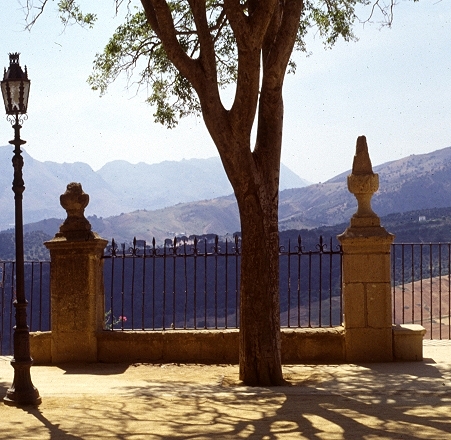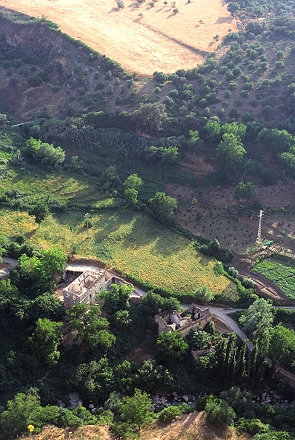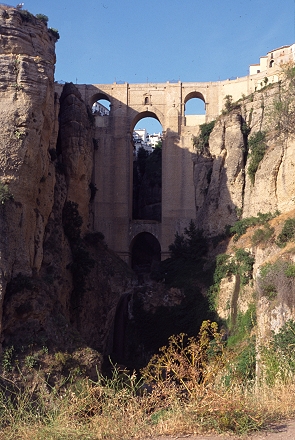| Currently Gallery Original Prints Books Bio Contact Home |
 |
 Crows Nest Pass |
|||||||||||||
Or, as we came refer to this piece, in the most affectionate way of course, “The Hangin' Tree.” Though I didn't know it at the time, this one landmark, which is/was located along the highway through Crow’s Nest Pass (the most southern route through the Rockies from British Columbia to Alberta), is one of note. Among the locals at least, it was known as “The Chinook Dancer.” As you may have noticed with most of the pieces that finally ended up in my own collection, they generally have a dark or somewhat brooding appearance, which is how this piece acquired its name – a passing comment that stuck. It is also interesting that the west, regardless of my own appreciation for these wilderness landscapes, has always had a limited appeal. Even Arctic landscapes, which also appeal to only a very specific audience, have proven far more marketable than these western scenes, and thus, many of them have remained with me. Most places in the U.S., the UK, and Canada, markets are very regional in their appreciation of different subject matter. Only the larger centers, such as Toronto, have a more general, cosmopolitan taste, nevertheless, the West has always been a tough sell here. So, all these years later, I continue to enjoy paintings such as “Crow’s Nest Pass,” as reminders of those magic moments in life's journey. As it happens, this trip was an especially fruitful one, resulting in approximately a dozen paintings (which, with the exception of “Crow’s Nest Pass,” are all sold) This particular road trip was to participate in one of the Pacific Rim Art Exhibitions near Seattle, and took me west through, Colorado, Wyoming, Idaho and Washington State. The plan was to return home again by way of Vancouver, then east along the most southerly Canadian route (through the pass) to Alberta and Saskatchewan. Although my intention was to complete the journey home across Manitoba, and around the north side of the Great Lakes. Things didn't quite work out as I'd originally hoped however, but life is funny this way. Often, the inconveniences we encounter along the way are actually blessings in disguise. The following is a short story, which took place the following day, just outside Medicine Hat: Saskatchewan – 1991 Moose Jaw and Head-smashed-in-Buffalo-Jump – which I can still hardly believe are real place names – were now far behind me; Medicine Hat was fast approaching. I passed through the town and drove for some time before realizing that I should probably have stopped there. It was late, and the odds of finding a motel any time soon were slim, so I decided to turn around and head back. A side road finally appeared on the right and I pulled in to make a wide turn. Once I'd pulled off the pavement however, my wheels, though turned, did not affect the direction of the car at all; I quickly pointed them straight ahead again, so as not to immediately plough into the mud, and rolled slowly along the dirt road. Wet, sticky clay now had me in its grip; though my drive wheels continued to turn, forward motion gradually slowed as the wheels, caked with mud, sank in. I let my foot off the gas pedal rather than trying to accelerate out, which would have certainly dug the car in deeper. I was going no further. It was completely black outside, and there was not a car on the road. There was no point even doing a walk-around. Having grown up in the country, I'd seen this sort of mud before. So I climbed over the seat back, grabbed my sleeping bag and stretched out, as best I could, on the seat behind. Dawn would probably arrive long before the first passerby. I would deal with this problem in the morning.-----When I awoke, after a long and surprisingly deep sleep, it was already light. My legs were cramped and my arm numb – I’m sure I hadn’t moved from that position for the entire night. As I rose up to peer around, the first thing that caught my eye was not the surrounding landscape, now dusted with fresh snow, but the curious faces of a dozen or so prong-horned antelope. Most were grazing on the long grass that peeked through the snow on the side of the road, but others, presumably crossing over from the field behind me, stood all around my car. Why they would have chosen to cross here I could not imagine; but they gazed at me, and I peered back at them. When finally I moved, in order to reach my camera, the entire group bolted in unison. I fumbled to quickly open the window and managed just a couple of shots as they jumped the fence, and darted up the nearby slope. Reaching the top of a nearby hill the sun caught their flanks, flashing stripes of bright orange and yellow against the dusty blue sky as they disappeared over the crest. I tied my shoes and slipped on a fleece, swung open the door and stepped out. The ground, which had been a sticky quagmire the night before, had acquired an inch or two of frozen crust. I might not have to call for a tow after all. With a tire iron I carefully chipped the frozen muck from around the tires - and out of the wheel wells, where it had almost filled the space between the tread and the body of the car. The wheels were still sitting in wet mud below however, and I guessed I’d have one chance to break free before they sank in further. As it was, if I'd have kept my foot on the accelerator just a second or two longer the night before, the car would already have been too deeply embedded to drive out. A pile of tumbleweed had collected along the fence, in the direction that the antelope had disappeared; I gathered them up and jammed as many as possible tightly under the drive wheels. After the engine had run for a while and thoroughly warmed through, I put the car in gear and gingerly let out the clutch. As though out of a parking spot at the mall, the car rolled effortlessly forward and out onto the firm surface. I took a moment to survey the scene, not quite believing my good fortune, then reversed, smoothly and steadily, straight back to the paved road. There was still not a car on the highway as the sun peeked between layers of cloud, low on the horizon.
An hour or so passed and traffic was light in both directions. Luckily, driving east, as the sun broke through the cloud cover I happened to notice the road surface glistened and I let the car slow. Moving along at a steady pace, each time I touched the accelerator to maintain that speed, the rear wheels lost traction and the back of the car began to drift; touching the brakes was just as perilous. A hand full of cars passed me by, slowly, traveling in the opposite direction; but others, having not adjusted their speed in time, were scattered at regular intervals alongside the road. At one point a tractor-trailer had jack-knifed and it sat, folded back on itself, on the sloping embankment of the road. The pace was excruciatingly slow and as I stared towards the unbroken horizon in the far distance; it seemed I was inching along. A road sander did not appear until after Swift Current and even then, despite the traffic, treacherous patches of ice remained. Just before Moose Jaw, the sky had clouded over again and it began to snow. When an exit to the south appeared a short distance beyond the town, I took it. According to the radio, the road east promised more of the same, so I decided to take my chances south of the border. Highway 39 branched off the Trans-Canada and headed Southeast towards Estevan, and a short while later I was in the U.S., once again. North Dakota is dotted with wind-swept ghost towns. Long since abandoned, these little clusters of buildings have gradually been pushed over by the relentless winds; many of them now lean, precariously, at the same unlikely angle, the last point at which their supporting timbers are able to maintain a generally upright position. This tipping point can be maintained only so long before gravity suddenly brings the entire structure down, and I was captivated at the tension of these forms. This image, and the antelope I saw that morning, were etched in my mind.
Though a little disappointed at not having completed my journey as intended, three paintings, variations on the theme, evolved out of these unexpected yet fortuitous events. The first became part of a major exhibition in Seoul in 1992. The second (above) was the first piece to be purchased, and sold, by a new gallery in the Vancouver area. The Whiterock Gallery, which became my home away from home for ten years, is a relationship that endures to this day. The final piece, created a number of years later, sold in auction at the Thomas Gilcrease Museum in Tulsa, Oklahoma. Return to main page |
||||||||||||||
 |
 Fading light |
|||||||||||||
The setting for this image is Canyon de Chelly in Eastern Arizona. The changing light in the desert is endlessly fascination, and particularly in the canyon country. The interplay of light and shadow, which is so pronounced in the high desert, seems to constantly reshape the landscape. The harsh, hard edged shadows so overpower the subtleties of the softly contoured land, that our eye perceives these first; thus, from dawn to dusk, as the sun moves across the sky, the desert world changes radically. The speed at which this change takes place is also captivating. Standing beside the vertical sandstone walls on the canyon floor, because of the scale, the movement of the sun is perceptable. Second by second the shadow's movement across the rock face can be easily discerned, as the sun rises high overhead, then drops, just as quickly, towards the western horizon. As it happens, Fading Light was particularly well named. The reference, obviously, is to the fading light of late afternoon, but it has always been of interest that the last splash of light on the tree in the center of the composition responds directly to the ambient light, wherever the piece is displayed. It has long been something of a novelty that, as the light dimmer switch over the dinning room table is adjusted, the fading light in the desert canyon scene reacts according; the shadows fade to black, yet the light of the cottonwood continues to glow. This was an unintentional effect of course, and something I discovered long after the fact. Despite this rather interesting phenomenon, there is a much more personal story behind this work. I first visited Canyon de Chelly in 1988, en route to Mexico. Though I did return to the Southwest during the intervening years, it wasn't until 2009, twenty years later, that I next returned to this place. The following inlcudes excerpts from my own journal, and from Washington Matthew's, 1904 publication "Navaho Legends" *:
Canyon de Chelly – Arizona 2009 There is a wonderful story of the journey, the quest, of the Navajo warrior twins: Wandering in the desert the young twins come across the home of grandmother spider who lives in a dark hole in the ground. From within, a voice invites the twins to enter. They descend into the smoky home using a ladder. Grandmother spider welcomes them and asks them where they are going. In one version of the story their first response is “we don’t know where we’re going, we’re just walking.” * Through a long series of questions in which she almost puts the idea into their heads, it is revealed that they are looking for “the house of their father, the sun.” She gives them an incantation to pacify the monsters and wild animals they will meet, amulets and charms, such as “the feather of the alien gods,” and a "Life Feather" to protect them from harm while on their journey. Among the dangers they would encounter were “the rocks crush the traveler, the reeds that cut him to pieces [and] the cane cactuses that tear him to pieces.”* This part of the story was repeated to me by a Navajo woman I met in Arizona, while exploring more of the “Grand Circle” in October 2009.
Seven mountains were then formed, four of which bounded the land of the Navajo. The mountain in the east, where the sun would rise, was fastened to the earth with a lightening bolt. Tsisnadzi'ni was covered with a sheet of daylight, and into it was put Crystal Boy and Crystal Girl. When they entered the earth, they became alive. Two pigeons were born there, from eggs that had been placed at the summit. In the North was formed Depe'ntsa, it was fastened to the earth with a Rainbow. It was adorned with black beads and dark clouds, many kinds of plants and wild animals. Two eggs were placed there, and from them were born two blackbirds. Lastly, Pollen boy and Grasshopper Girl were placed inside the mountain to dwell. All of this came to pass as the lake that had covered the land was drained away by four rivers. These were created by Blue Body, when he threw four stones he had brought with him from the lower world, to the cardinal points. Holes were broken there, from which the rivers could flow.* The early people sought to foretell their future, and to do this one of them placed a hide-scrapper in water, saying, “If it sinks we perish, if it floats we live.” It floated, and all were happy; until along came Coyote, who said, “Let me divine your fate.” He picked up a stone and repeated, “If it sinks we perish, if it floats we live.” It sank, of course, and all were angry with him and reviled him; but he answered them saying: “If we all live, and continue to increase as we have done, the earth will soon be too small to hold us, and there will be no more room for corn fields. It is better that each of us should live but a time on this earth, and then leave and make room for our children.”* But, since the time of the great lake, the desert rivers have not always carried water to the people, and many moved away from that place. Return to main page |
||||||||||||||
 |
 Afuera la Fiesta |
|||||||||||||
Return to main page |
||||||||||||||
 |
 Awash |
|||||||||||||
"Near the town of Little Hearts Ease, Trinity Bay, Newfoundland, this abandoned fishing boat captured my imagination and compelled me to put paint to canvas. Its battered hull, awash in the sparkling blue sea, seems emblematic somehow of a way of life gone by. Only vestiges of the old-world now remain, swept aside by the inexorable tide of time." Although this painting "Awash" was created in 2004 (The text above was written at the time of its first showing), the scene itself was from a visit to Newfoundland in May 1991 – one of two trips that year paid for by the American publishing house, Greenwich Workshop. The idea had been that I would gather material for a collection of new paintings, from which they create a series of prints. Potential images were always vetted by the dealers however, before they were produced, and, though I did create a number different paintings from this trip, none of them were actually published. According to the print galleries in the early 1990s, my new works did not have "sufficient commercial appeal." I was disappointed at the time of course, but I did feel a certain pride that my work wasn't "commercial" and, a short time later, I signed with a Canadian publishing company. Ironically, this image was ultimately produced in the form of a Jig-saw puzzle. I hasten to add, it was the only time I licensed an image to be produced in this fashion. The inventory is long since out of stock and I have not had other images reproduced this way. Though I may sound a little disparaging of such things, I certainly don't mean to be. It was swayed, in this case, because of the other artists involved. In the catalogue my image appeared next to the west coast painter Carol Evans, and exceptionally talented artist with whom I've exhibited, on a couple of occasions, at the Whiterock Gallery (Vancouver). As much as I respect Carol's work however, it was the other names that clinched this deal: Emily Carr, E. J. Hughes, Lawren Harris and Alex Colville. I cannot tell you what a thrill it was to have my painting published along side works by these other "Iconic" Canadian artists. Return to main page |
|
||
| © W. David Ward All rights reserved |


